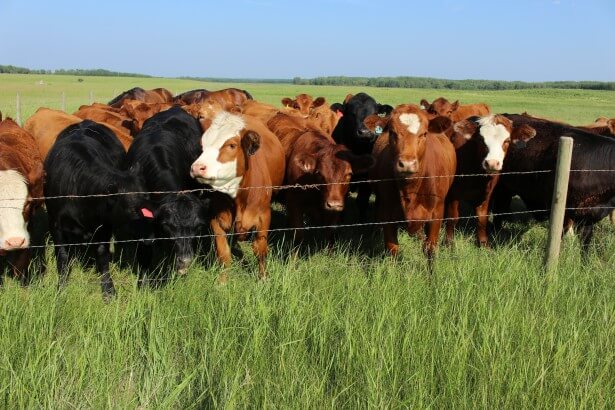Is it worth seeking a grass-fed certification for your farm?
The demand for grass-fed meat is on the rise globally, driven by consumers’ growing awareness of the health and environmental benefits of grass-fed products. Is it worth seeking a grass-fed certification for your farm? Let’s take a look at the pros and cons.

“There is no legal definition for ‘grass-fed’ which can be misleading for both producers and consumers.”
To start with, there is no legal definition for ‘grass-fed’ – while organic beef production is legally circumscribed, with a long list of what’s allowable and not (for example, here) – which can be misleading for both producers and consumers.
“About 4% of U.S. beef retail and food service sales are comprised of grass-fed beef with a value of roughly $4 billion. About $3 billion of that is unlabeled grass-fed beef that is sold as conventional beef, making data gathering on these products difficult to obtain,” wrote Pete Bauman and Dr. Allen Williams, Grass-fed Insights, LLC.
On the other side of the Atlantic, in Europe, the same difficulties arise even though the European Commission “will allocate €185.9 million in 2023 to fund promotion activities for sustainable and high-quality EU agri-food products in the EU and worldwide.”
In Australia and New Zealand, grass-fed beef and lamb is considered premium product and is known for their high quality and taste. The country has a long history of grazing and grass-fed beef, and it’s a major exporter of grass-fed products to Asia and Europe.
“The grass-fed beef sector has grown to the point that the food service sector is actively involved in grass-fed beef production and marketing.”
Despite the lack of data, the grass-fed beef sector has still grown to the point that the food service sector is actively involved in grass-fed beef production and marketing. Many brands and major packers are now offering grass-fed options to meet consumer demand, such as the fast-food chains McDonald’s, Burger King or Wendy’s.
As the grass-fed label is not regulated, educated consumers have started to look for third-party certifications on the product they buy, such as the American Grassfed Association (AGA) or the Food Alliance Grassfed (FAG), that verify that the animals have been raised on a diet of only grass or forage.
Obtaining a grass-fed certification for a farming operation can vary in difficulty depending on the specific certifying organization and the location of the operation. In general, the process typically involves a combination of on-site inspections, record-keeping, and documentation review. The process can take several months and requires an application fee, inspection fee, and annual membership fee. The most common standards include:
- Feeding the animals exclusively on grass and forage from weaning to harvest
- No confinement of animals
- No use of hormones or antibiotics
- Providing animals with access to pasture during the growing season
- Meeting specific animal welfare standards
- Farmers must also keep detailed records of their feeding and management practices and allow for regular on-site inspections.
There are several certifying organizations around the world. In North America, the American Grassfed Association (AGA) is one of the most widely recognized. In Europe, the Pasture for Life certification, which is run by the Pasture-Fed Livestock Association, is one of them. A well-known organization in Australia is the Australian Grassfed Accreditation Program (AGAP).
It’s important for farmers to carefully weigh the costs and benefits of obtaining certification before making a decision. Here are below the Pros and Cons we identified:
| ✔️ Pros | ❌ Cons |
| Premium pricing: Grass-fed products can command a premium price in the market, and a certification can help farmers differentiate their products and secure higher prices for their grass-fed products. |
Costs: Obtaining a certification can be a costly process, with expenses including application fees, inspection fees, and annual membership fees. |
| Increased market access: Certification can open up new market opportunities for farmers, particularly in the export market, where certifications are often required by buyers. |
Time-consuming: The certification process can be time-consuming, and farmers may need to devote significant resources to preparing for inspections and maintaining records. |
| Consumer trust: A certification can help to build consumer trust and confidence in a farmer’s products, as it demonstrates that the farm is adhering to a set of rigorous standards. |
Requirements may not match farm’s practices: The requirements for certification may not align with a farmer’s current practices or may not be feasible to implement on their farm. |
| Improved sustainability: Certification can help to promote sustainable farming practices, by requiring farmers to meet standards related to animal welfare, environmental stewardship, and land management. |
Inspection and record-keeping burdens: Certification requires regular on-site inspections and farmers need to keep detailed records of their feeding and management practices, this can be a burden for farmers and may not be feasible for small-scale operations. |
| Brand differentiation: A certification can help farmers to create a distinct brand and reputation for their grass-fed products, which can help to increase consumer awareness and demand for their products. |
Limited number of certifying organizations: There are a limited number of certifying organizations, and not all of them are available in all regions. The farmers need to do research to find the certifying organization that best fits their farm’s operation. |
| Marketing advantage: A certification can provide a marketing advantage as it allows farmers to communicate their grass-fed products as a healthier, more sustainable and tasty option. |
Lack of regulation: Some certifying organizations do not have strict regulations in place to ensure that the farmers are actually following the grass-fed standards, this can lead to misleading labeling and false advertising. |
| Compliance with regulations: Some certifications may also be required by laws and regulations, and obtaining a certification can help farmers to comply with these regulations. |
Lack of recognition: Some certifications may not be well recognized or respected by consumers or buyers, which can limit the benefits of obtaining certification. |
In summary, grass-fed certification can be a solid marketing tool for farms seeking to differentiate themselves in the marketplace. Consumers are searching for environmentally sensitive, humanely raised food products, and grass-fed production fits the bill. Obtaining certification is a rigorous process, but one that can reap benefits for farmers who invest in their product from start to finish.
“Obtaining certification is a rigorous process, but one that can reap benefits for farmers who invest in their product from start to finish.”
Grass-fed operations are not restricted to conventional farms, and non-conventional operations are not restricted to grass-fed production. In other words, it can be difficult to make these blanket statements about sustainability and certification, mainly because everyone is different – but that’s exactly as it should be. It was an interesting discovery, but again – there is no one-size-fits-all approach to farming and livestock management.
You may also like to take a look at some of these great resources:
- The Art of Sustainable Hay Feeding in a Tough Economy
- Benefits of feeding long-stem hay, especially when weaning calves
- Does it really make sense to ground-feed onto mud?
- Increasing Soil Fertility and Forage Production through Pasture Management
- How to deal with hay shortage in drought conditions
- Improve your pasture for free with your bale feeding routine
- 8 Benefits to rotational grazing
Here at Hustler, farming sustainably is at the heart of everything we do.
Our belief in sustainable farming practices underpins our range of world-leading livestock feeding solutions. If you are looking for farming equipment near you or buying livestock feeding equipment, contact our friendly team today!




























